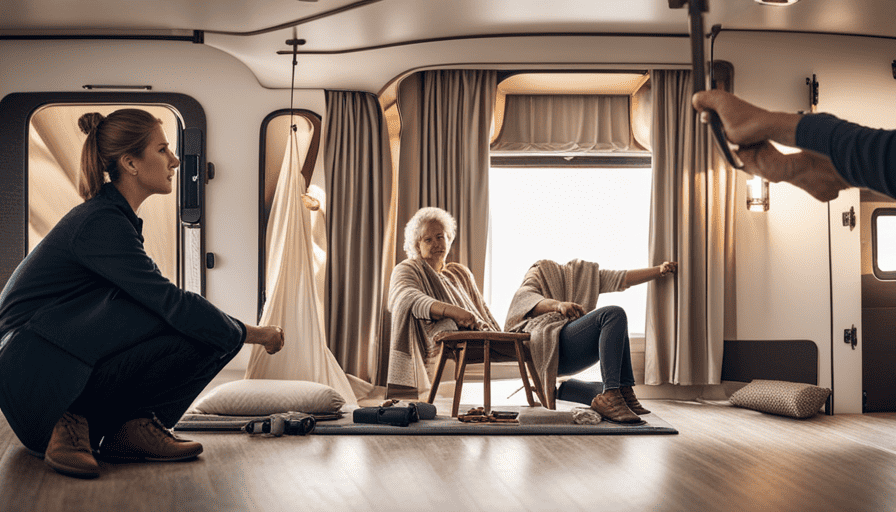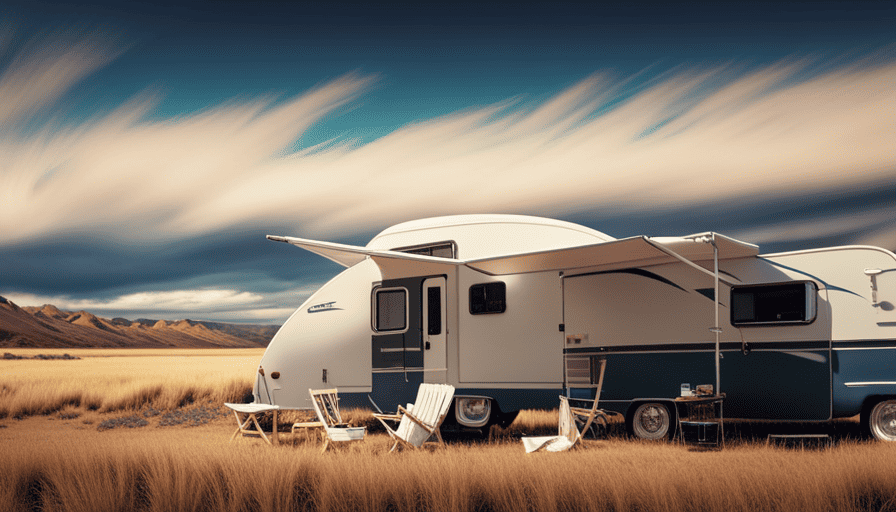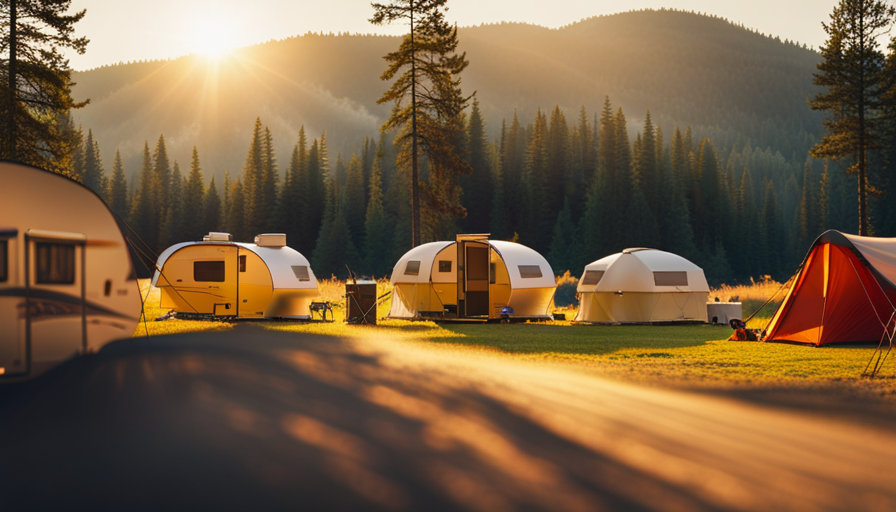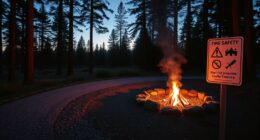Imagine this scenario: you’re enjoying a camping trip, surrounded by nature in your comfortable camper. Suddenly, the alarm for carbon monoxide goes off, instilling immediate fear in you. It’s crucial to quickly take steps to protect not just your own safety but also that of those camping with you.
In this article, we will guide you through the essential steps of turning off a carbon monoxide alarm in your camper. Safety is our top priority, so we will provide you with detailed instructions and tips to handle this situation effectively. From identifying the source of the alarm to properly ventilating the area, we’ve got you covered.
We’ll also explain how to locate the alarm reset button and follow the manufacturer’s instructions. Remember, it’s crucial to test the alarm to ensure it’s functioning correctly and take preventive measures to avoid false alarms. However, if you’re unsure or need assistance, don’t hesitate to seek professional help.
So, let’s dive in and learn how to keep your camper safe from carbon monoxide hazards.
Key Takeaways
- Locate the reset button on the carbon monoxide alarm and follow manufacturer’s instructions to turn it off.
- If unsure about how to turn off the alarm, refer to the manufacturer’s instructions for guidance.
- Installing multiple carbon monoxide alarms in the camper, especially near sleeping areas, is recommended for optimal safety.
- Regularly test the alarm to ensure proper functioning and replace batteries at least once a year.
Understand the Importance of a Carbon Monoxide Alarm in Your Camper
You can’t underestimate the life-saving power of a carbon monoxide alarm in your camper. It’s crucial to understand the importance of regular maintenance and the different types of carbon monoxide detectors available on the market.
Regular maintenance is essential to ensure that your carbon monoxide alarm is functioning properly. Make sure to test it regularly, following the manufacturer’s instructions. Additionally, replace the batteries at least once a year or as recommended by the manufacturer. Regular maintenance will help to ensure that the alarm is always ready to alert you in case of a carbon monoxide leak.
There are two main types of carbon monoxide detectors: plug-in and battery-operated. Plug-in detectors are typically more reliable as they’re directly connected to a power source. They often come with a battery backup to ensure continuous operation during power outages. On the other hand, battery-operated detectors are portable and can be placed anywhere in your camper. They’re easy to install and don’t require any wiring.
Understanding the importance of regular maintenance and the different types of carbon monoxide detectors will help you ensure the safety of your camper. Now, let’s move on to the next section and learn how to identify the source of the alarm.
Identify the Source of the Alarm
First thing to do is locate the culprit setting off the alarm, like finding a needle in a haystack. Identifying the source of the alarm is crucial to ensure your safety in the camper.
There are common sources that can trigger a carbon monoxide alarm, such as malfunctioning appliances, blocked vents, or exhaust leaks. Inspect your camper thoroughly, checking all the appliances and their connections. Look for any signs of carbon monoxide leaks, such as soot or discoloration around vents or unusual smells. Pay close attention to the stove, furnace, water heater, and generator, as these are often the main culprits. It’s important to address any issues immediately to prevent further exposure to carbon monoxide.
Once you have identified the source of the alarm, it is essential to take necessary precautions to ensure your safety. Check for actual carbon monoxide exposure by monitoring yourself and others for symptoms like headache, dizziness, nausea, and confusion. If you or anyone else experiences these symptoms, seek fresh air immediately and call emergency services. Remember, carbon monoxide is a silent killer, and it’s crucial to take every precaution to protect yourself and your loved ones.
Check for Actual Carbon Monoxide Exposure
Once the source of the alarm has been located, it’s crucial to assess if there’s been any actual exposure to carbon monoxide. This odorless and colorless gas can be extremely dangerous, and immediate action should be taken if exposure’s suspected. Here are some important steps to follow:
-
Check Symptoms: Pay close attention to any symptoms that may indicate carbon monoxide poisoning. These can include headache, dizziness, nausea, weakness, and confusion. If you or anyone else in the camper experiences these symptoms, it’s important to take them seriously.
-
Seek Medical Attention: If you or anyone else’s showing symptoms of carbon monoxide poisoning, it’s important to seek medical attention immediately. Carbon monoxide can be life-threatening, and medical professionals’ll be able to provide the necessary treatment and support.
-
Stay Calm and Move to Fresh Air: If there are no symptoms of carbon monoxide exposure, it’s still important to stay calm and move to a well-ventilated area. Open windows and doors to let fresh air in and help ventilate the space. This’ll help reduce the concentration of carbon monoxide in the camper.
By checking for symptoms and seeking medical attention if necessary, you can ensure the safety and well-being of everyone in the camper. Now, let’s move on to the next step of opening windows and ventilating the area.
Open Windows and Ventilate the Area
To ensure the safety of everyone in the camper, it’s essential to open windows and ventilate the area, as this can significantly reduce the concentration of harmful gases. Did you know that proper ventilation can decrease the risk of carbon monoxide poisoning by up to 75%?
When dealing with a carbon monoxide alarm in your camper, it’s crucial to take ventilation precautions. Open all windows and doors to allow fresh air to circulate throughout the space. If possible, turn on any fans or vents to enhance the airflow. This will help to dilute the carbon monoxide and reduce its concentration.
In addition to opening windows, there are alternative safety measures you can take. Consider moving everyone outside the camper and into a safe, well-ventilated area. If the weather permits, set up a temporary outdoor living space until the issue is resolved. This will ensure that you and your companions are away from the source of carbon monoxide and breathing clean air.
Now that you’ve taken the necessary ventilation precautions, let’s move on to the next step: locating the alarm reset button.
Locate the Alarm Reset Button
Now that you’ve ensured the camper is well-ventilated, let’s find where the reset button is located on the alarm. It’s important to regularly maintain your carbon monoxide alarm to ensure it functions properly and keeps you safe.
One common issue that may arise is the alarm going off for no apparent reason. To troubleshoot this, locating the reset button is crucial.
The reset button is usually found on the front or side panel of the alarm. It’s typically labeled with the word ‘reset’ or identified by a small button marked with an arrow pointing towards it. Look for this button and make sure you can easily access it in case of an emergency.
Press and hold the reset button for a few seconds until the alarm stops sounding. This action will reset the alarm and silence any false alarms. If the alarm continues to sound even after pressing the reset button, it may indicate a more serious issue, and you should contact a professional to inspect and repair the alarm.
By understanding the importance of regular maintenance and knowing how to troubleshoot common issues, you can confidently operate your carbon monoxide alarm in the camper. So, let’s move on to the next step and explore how to press and hold the reset button to ensure the alarm is properly reset.
Press and Hold the Reset Button
With a firm grip, hold down the reset button on the alarm, allowing a sigh of relief to wash over you as the blaring sound dissipates.
It’s important to remember that pressing and holding the reset button is just one method for turning off a carbon monoxide alarm in a camper. If the alarm continues to sound even after resetting, there are alternative troubleshooting steps you can take.
To troubleshoot the carbon monoxide alarm, consider the following options:
-
Check the battery: Ensure that the battery is properly installed and fully charged. A weak or dead battery can cause false alarms or prevent the alarm from turning off.
-
Test the alarm: Use the test button to verify if the alarm is functioning properly. If it fails the test, it may need to be replaced.
If you have tried these troubleshooting steps and the alarm still won’t turn off, it is crucial to follow the manufacturer’s instructions for your specific carbon monoxide alarm model. These instructions will provide guidance on how to safely and effectively silence the alarm.
Transitioning into the next section, it’s important to always follow the manufacturer’s instructions to ensure the proper operation and maintenance of your carbon monoxide alarm.
Follow Manufacturer’s Instructions
By adhering to the manufacturer’s instructions, you can ensure the proper operation and maintenance of your CO alarm in your camper. It’s important to understand the different types of carbon monoxide alarms available and which one is installed in your camper.
Some alarms may have a reset button that needs to be pressed and held to turn off the alarm. However, it’s crucial to note that this should only be done after you’ve addressed the source of the carbon monoxide and ensured that it’s safe to do so.
If you’re unsure of how to turn off your CO alarm, it’s always best to refer to the manufacturer’s instructions. These instructions will provide you with specific guidance on how to properly reset the alarm.
It’s also important to install multiple carbon monoxide alarms in your camper, especially near sleeping areas, to ensure that everyone is alerted in case of a carbon monoxide leak.
Once you’ve successfully turned off the alarm, it’s crucial to test the alarm to ensure it’s functioning properly. This will give you peace of mind knowing that you and your loved ones will be alerted in the event of a carbon monoxide leak.
Test the Alarm to Ensure it is Functioning Properly
Make sure to give your life-saving device a thorough check to ensure it’s on top of its game. Testing the alarm functionality is crucial to ensure that it will effectively alert you in the event of a carbon monoxide leak.
Begin by locating the alarm’s test button, usually located on the front or side of the device. Press and hold the test button for a few seconds until the alarm sounds. If the alarm doesn’t sound, it may indicate a problem with the device. In that case, refer to the manufacturer’s instructions for troubleshooting alarm issues or consider replacing the alarm altogether.
Additionally, it’s important to regularly change the batteries in your carbon monoxide alarm to ensure optimal performance. By regularly testing the alarm and taking preventive measures to avoid false alarms, you can have peace of mind knowing that you and your loved ones are protected from the dangers of carbon monoxide.
To take preventive measures to avoid false alarms, it’s important to educate yourself about the sources of carbon monoxide in your camper and how to properly use appliances, such as stoves and heaters, that produce carbon monoxide.
Take Preventive Measures to Avoid False Alarms
Before we move on to the next step, let’s make sure the carbon monoxide alarm in your camper is working properly. Testing the alarm regularly is crucial for your safety.
Now, let’s dive into the current subtopic – taking preventive measures to avoid false alarms.
Preventive measures play a vital role in ensuring that your carbon monoxide alarm functions accurately and doesn’t trigger false alarms. Firstly, keep the alarm away from any potential sources of carbon monoxide, such as fuel-burning appliances or generators. This will help prevent the alarm from detecting harmless levels of carbon monoxide.
Additionally, avoid placing the alarm near areas with excessive humidity, as moisture can interfere with its sensors. Regularly clean the alarm using a soft cloth to remove any dust or debris that may accumulate on its surface.
Remember to replace the batteries in your carbon monoxide alarm at least once a year, or as recommended by the manufacturer. This will ensure that the alarm remains powered and capable of detecting any potential carbon monoxide leaks.
By implementing these preventive measures, you can significantly reduce the chances of your carbon monoxide alarm sounding a false alarm and provide peace of mind during your camping trips.
Now, let’s move on to the next section, where we discuss seeking professional help if necessary.
Seek Professional Help if Necessary
If you ever find yourself unsure about the functionality of your carbon monoxide detection system, don’t hesitate to seek professional assistance to ensure your safety.
Carbon monoxide is a deadly gas that can be emitted from various sources in a camper, such as a faulty stove or a malfunctioning generator. It’s essential to have a working carbon monoxide alarm that can detect this gas and alert you in case of a leak. However, if you suspect that your alarm isn’t functioning correctly, it’s crucial to seek professional advice.
One option is to contact the manufacturer of your carbon monoxide alarm. They’ll have detailed knowledge about the product and can provide guidance on any troubleshooting or maintenance that may be required. They may also be able to recommend a certified professional who can inspect the alarm and ensure its proper functioning. It’s important to follow the manufacturer’s instructions and recommendations when seeking professional help.
In addition to contacting the manufacturer, you can also reach out to a licensed technician who specializes in carbon monoxide detection systems. These professionals have the expertise and equipment to accurately assess the functionality of your alarm and identify any potential issues. They can provide the necessary repairs or replacements if needed, ensuring that your carbon monoxide alarm is operating correctly and keeping you safe.
Remember, when it comes to carbon monoxide safety, it’s always better to be cautious and seek professional help if you have any doubts about the functionality of your carbon monoxide detection system. Your safety and the safety of your loved ones should always be the top priority.
Frequently Asked Questions
Can I simply remove the carbon monoxide alarm from my camper to turn it off?
Removing the carbon monoxide alarm from your camper is not recommended due to safety concerns. Carbon monoxide is a silent killer, responsible for an estimated 400 deaths each year in the United States alone. The alarm serves as a crucial early warning system to protect you and your loved ones from this deadly gas. It’s essential to keep the alarm properly installed and maintained to ensure your safety while enjoying your camper.
What are the potential risks of turning off a carbon monoxide alarm in a camper?
Potential dangers and health risks are associated with turning off a carbon monoxide alarm in a camper. By disabling the alarm, you eliminate the crucial warning system that protects you from this deadly gas. Carbon monoxide is a colorless and odorless gas that can be deadly if inhaled in high concentrations. Breathing in carbon monoxide can lead to symptoms like dizziness, headache, nausea, and even death. It is essential to keep the alarm functioning at all times for your safety.
How often should I test my carbon monoxide alarm in a camper?
It’s necessary to have a carbon monoxide alarm in a camper for safety reasons. To ensure its effectiveness, it’s recommended to test the alarm regularly. The frequency may vary depending on the manufacturer’s instructions, but generally, it’s advised to test the alarm at least once a month.
Additionally, it’s important to replace the carbon monoxide alarm according to the manufacturer’s recommendations, usually every 5-7 years. This ensures the alarm is functioning properly and providing adequate protection against carbon monoxide.
Can I use a carbon monoxide detector instead of a carbon monoxide alarm in my camper?
Yes, it’s possible to use a carbon monoxide detector instead of a carbon monoxide alarm in your camper. However, it’s important to prioritize safety. Carbon monoxide detectors are designed to alert you when dangerous levels of carbon monoxide are detected, but they may not meet the specific regulations for carbon monoxide alarms in campers. To ensure your safety, it’s recommended to check the local regulations and use a carbon monoxide alarm that meets the necessary safety standards.
Are there any specific maintenance requirements for carbon monoxide alarms in campers?
When it comes to the maintenance of carbon monoxide alarms in campers, there are a few important things to keep in mind.
Regularly checking and testing the alarm is crucial to ensure its functionality. Inspecting the power source and replacing batteries as needed is essential.
Additionally, cleaning the alarm and removing any dust or debris can prevent false alarms. Common issues with camper carbon monoxide alarms include expired sensors and malfunctioning components, so it’s vital to address these promptly for your safety.
Conclusion
In conclusion, we must always remember that our safety is of utmost importance, especially when it comes to carbon monoxide alarms in our campers. By understanding the significance of these alarms and following the necessary steps to turn them off, we can ensure our well-being on our camping adventures.
Just like a guiding light in the darkness, these alarms protect us from the silent dangers of carbon monoxide. So, let’s never underestimate their importance and always stay informed and prepared.
Happy camping, fellow adventurers!











